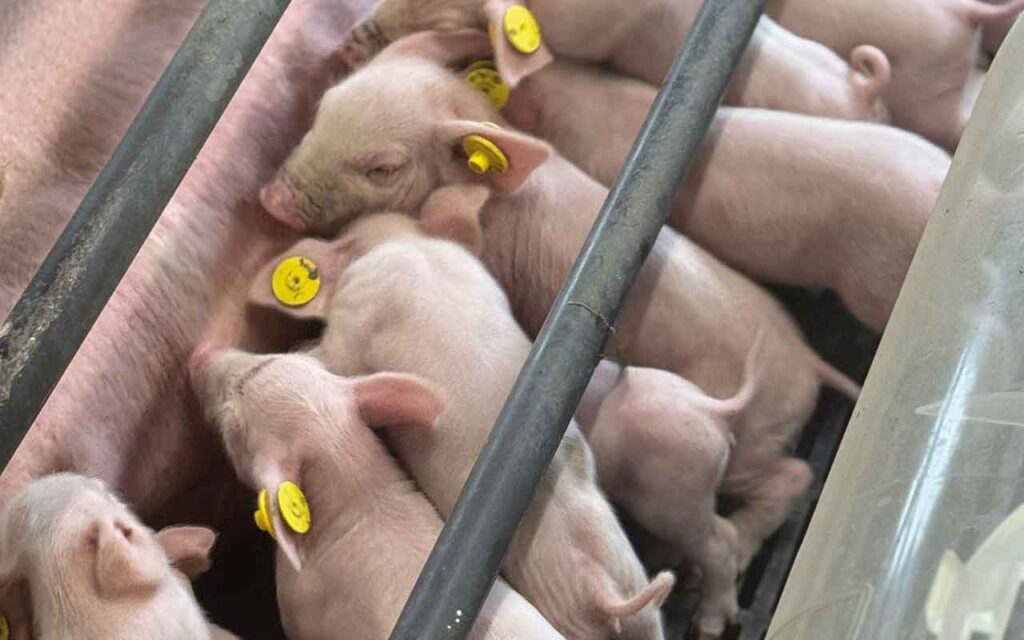The pig industry continues to innovate and adapt to optimise the management of modern hyper-prolific sows and larger litters.
The central aim is achieving healthy, high-quality piglets – and this was the focus of an autumn event hosted by Harper Adams University (HAU) and Ceva Animal Health.
About 30 pig vets and technicians came together for a tour of the Shropshire-based university’s 230-sow indoor breed-to-finish unit, which operates as a commercial business and a research and teaching facility.
The herd is currently averaging 131kg weaned per litter at 26.5 days, with about 16.5 piglets born alive per litter from sows with an average of 15 functioning teats.
They are currently weaning 15 pigs per litter and 36.4 per sow per year, at an average weaning weight of 8.65kg.
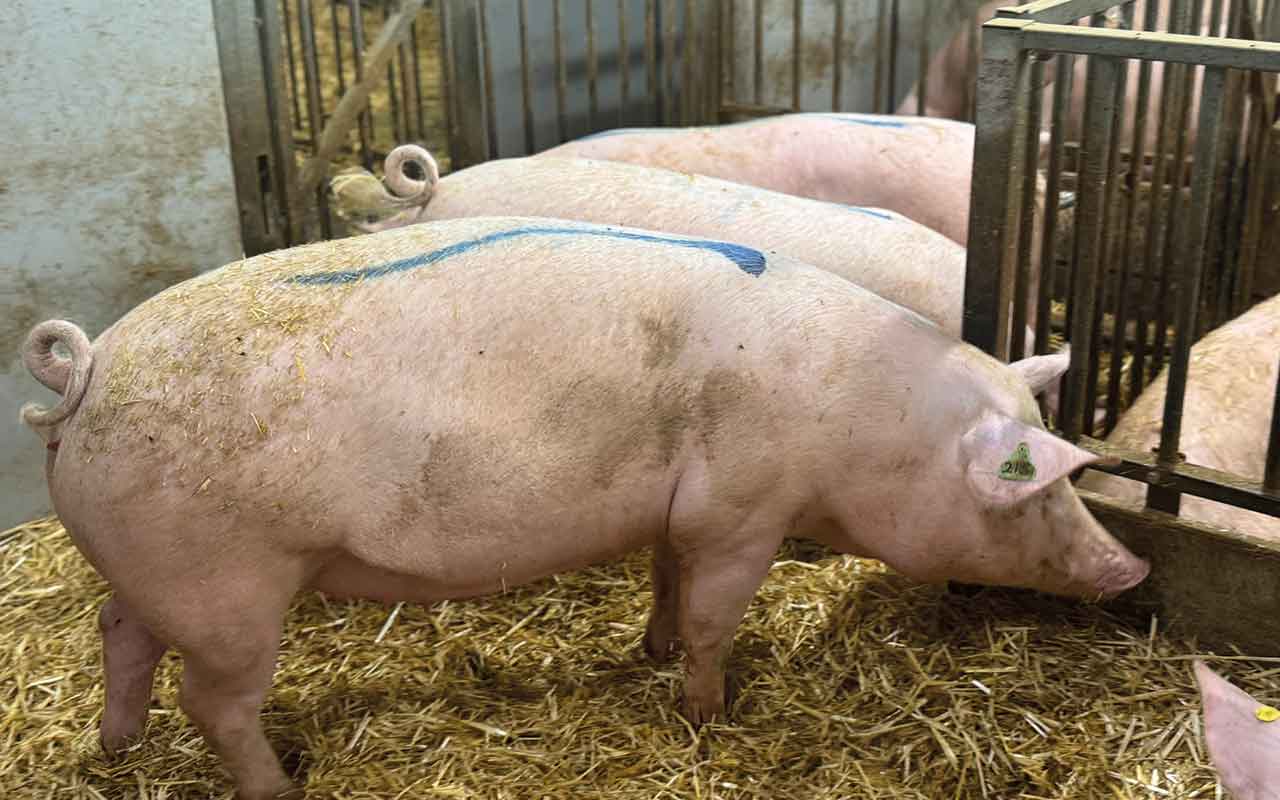
A number of strategies are in place to support the sow, from gilt management and sow nutrition in gestation and lactation to counting functional teats, colostrum management, offering supplementary milk and creep feeding.
Alan Stewart, HAU pig specialist and senior lecturer, highlighted how much the sow’s biology and performance have changed.
“The sows themselves are no bigger, on average, than they were 15 years ago, but they are rearing bigger litters and have more teats,” he said.
“On our unit, litter weight at weaning was averaging 122kg in 2022, which is 53% of the sow’s body weight, compared to 39% of her body weight in 2010. That’s just amazing, and our litter weaning weight has gone up further to 131kg, currently.”
Sow feed efficiency
National and HAU herd data for sow feed efficiency in 2024 showed the difference pig management and nutrition can make to physical and financial performance. HAU achieved 4.95kg of sow feed consumed/kg of piglets weaned, compared with 6.4kg for average herds and 5.92kg for the top 10% of herds nationally.
“It’s attention to detail in all aspects of stockmanship that add up, from batch management and hygiene to split-suckling litters,” Mr Stewart said.
The unit’s vet, Dimitrie Leonte, clinical director at Garth Pig Practice, added that if there is a well-trained team putting in the effort, good results are achievable on units with a conventional health status, like HAU’s.
“The herd is positive for flu, enzootic pneumonia and Glassers, but problems are not major. The starting point for any pig producer is to invest in team training and development, and then put all that knowledge and expertise back into the farm,” he said.
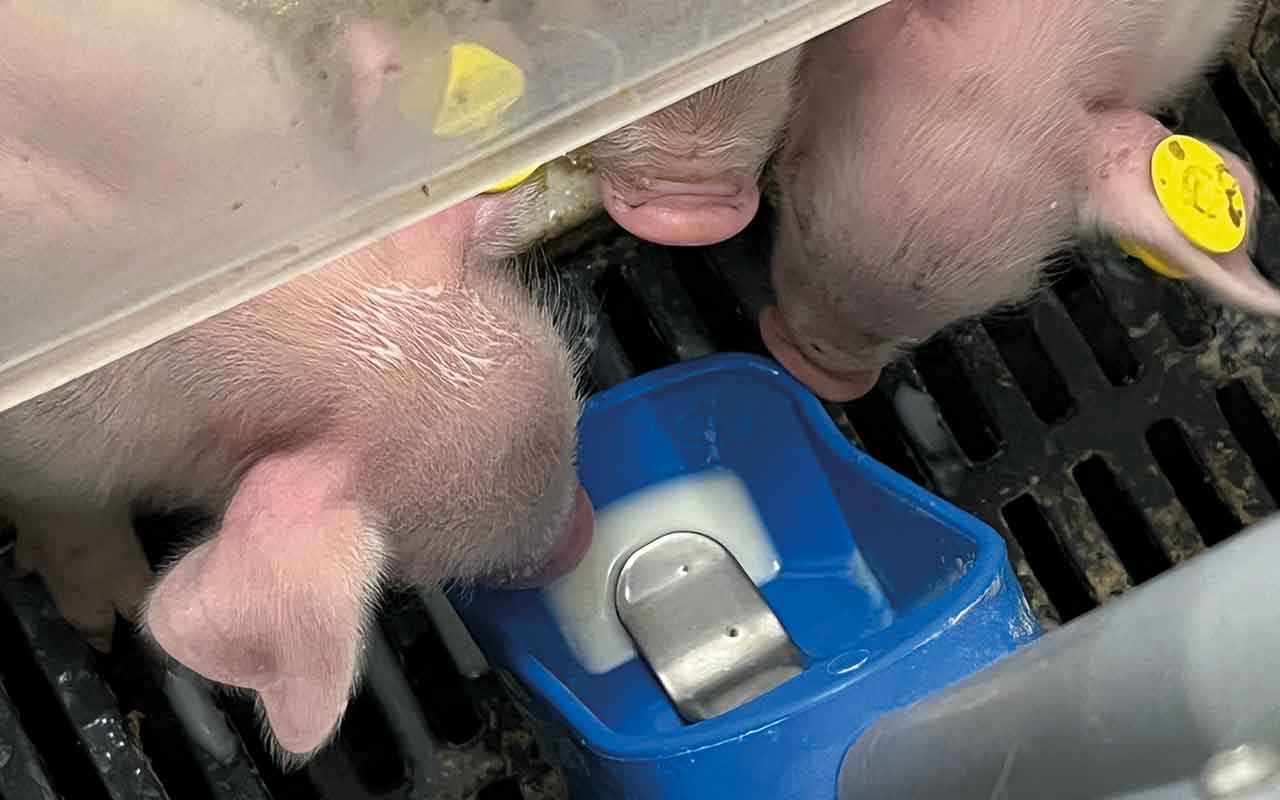
HAU pig researcher and pig unit deputy manager Sarah Icely also highlighted hygiene as a major factor in good health and performance. “Our three-week batch system means we can follow a thorough cleaning, drying and disinfection process,” she said.
Crucially, there is a seven- to 10-day period between each batch in the farrowing, nursery and finisher accommodation, allowing plenty of time for drying both before and after disinfection.
Gilts are now weighed regularly to help ensure they are following the breeding company’s recommended feeding curve, which has helped maintain condition and performance. Across the herd, 90% of sows conceive to their first service, with good body condition scores throughout the production cycle.
HAU research has found that making sure dry sows can feed without the stress of competition, as well as choice of lying area, is vital.
“Our 3.5sq m sow-operated feeders enable each sow to go in to eat individually and we have no aggression at feeding,” said Mr Stewart. “They each get the right amount of feed and there is less variation in sow condition. What is really key for welfare is that, even when it isn’t feeding time, dry sows have a choice of lying area.”
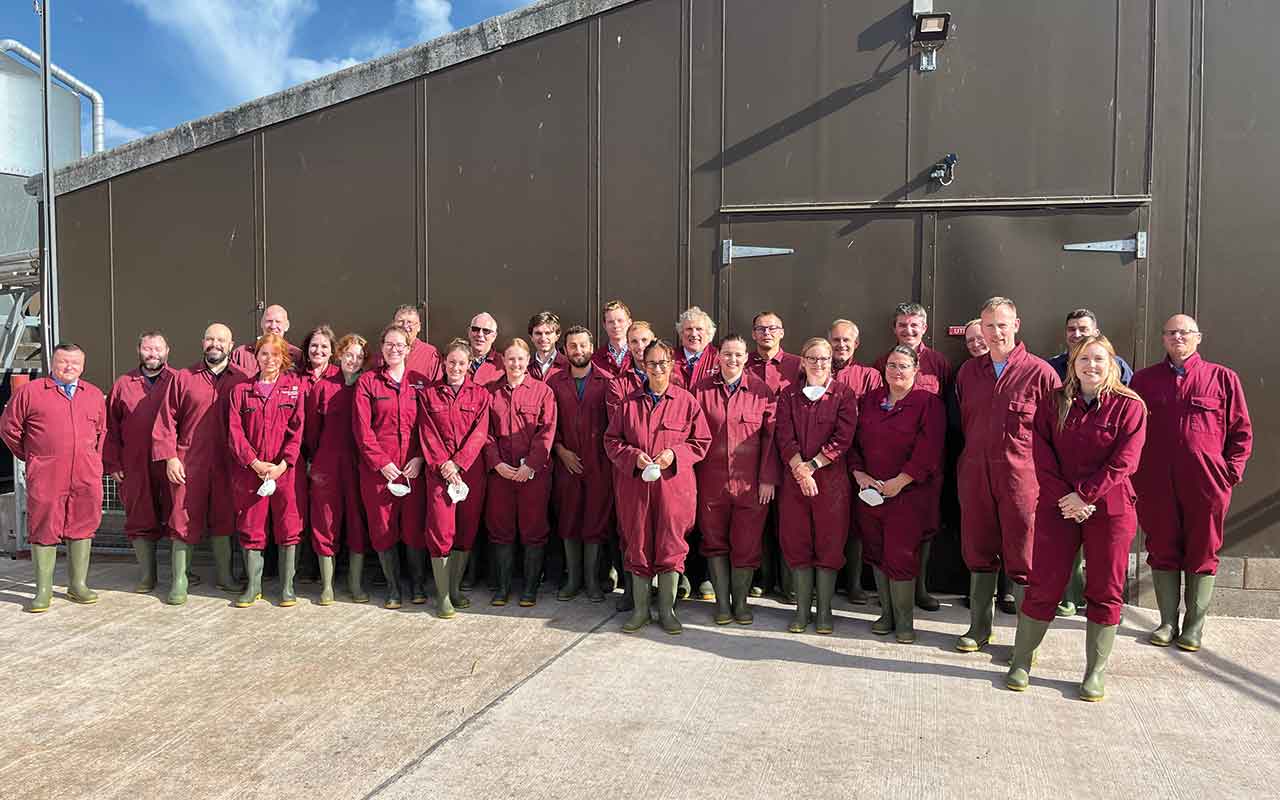
Up to 30% of laying behaviour observations show sows choose to lie in the individual feeding area, rather than the straw-bedded area. This implies they do not have to compete for their place in the hierarchy for lying space, which helps minimise the number of piglets lost during pregnancy.
HAU trials have shown the extra investment in sow-operated feeders can bring an average of 1.8 more piglets born per litter compared to systems that limit sow choices.
Two lactation diets are tailored to meet the needs of small and large sows during lactation, with both groups rearing large litters. The small-sow diet has only 3% crude fibre compared to 4.3% in the large-sow lactation diet, and there is a little more oil in the small-sow ration at 4.5% compared with 4.3% for the large sows.
“The small-sow diet is slightly more energy dense, so they don’t need to eat as much to get the same output,” Mr Stewart said.
In the farrowing house, the team bottle-feed colostrum to small piglets under 1kg birthweight, to give them enough energy to suckle themselves. “We’re not aiming to replace the sow,” said Dr Icely.
Where there are more piglets than functional teats, litters are split-suckled for up to two hours.
Supplementary milk and creep
Dr Icely’s PhD research investigated how to get the most benefit from supplementary milk and creep feed on the unit, which showed the supplementary milk system’s role is keeping more piglets alive.
“If smaller-birthweight piglets can’t access a teat to suckle, the milk bowl gives them another option, and the system has significantly increased piglet survival,” she said.
Supplementary milk has to be provided from birth to fully realise its benefits. Data showed the piglets that rely on the supplementary milk have noticeably higher intakes from the first week onwards compared to the other piglets, reinforcing the importance of supplying supplementary milk from birth. The milk must also be refreshed daily and the equipment disinfected between batches.
Currently, the piglets are offered milk from birth to three weeks old and creep is given from about 12 days old to weaning, at four weeks. “It’s important we have that week where both the supplementary milk and creep are available to the piglets while they get used to the creep,” Dr Icely said.
Withdrawing supplementary milk a week before weaning – initially to save costs – has also helped increase creep intakes. “Higher creep intakes lead to good gut development, higher daily gain and a lower feed conversion ratio in the first couple of weeks after weaning and all the way through to slaughter,” she said.
The smallest piglets are weaned into a separate pen of 20-25 pigs with a transition feeder.
“They’re not going to eat as much as the bigger pigs, but they do eat well, as they’re very self-sufficient, having learned to find the milk cups and creep from early on,” said Dr Icely. “They will have the same growth curve as the other pigs and will just be among the last of the batch to finish.”
The extra effort involved in rearing smaller pigs is repaid in the additional kilograms weaned and sold per sow.
Managing the flexible farrowing transition
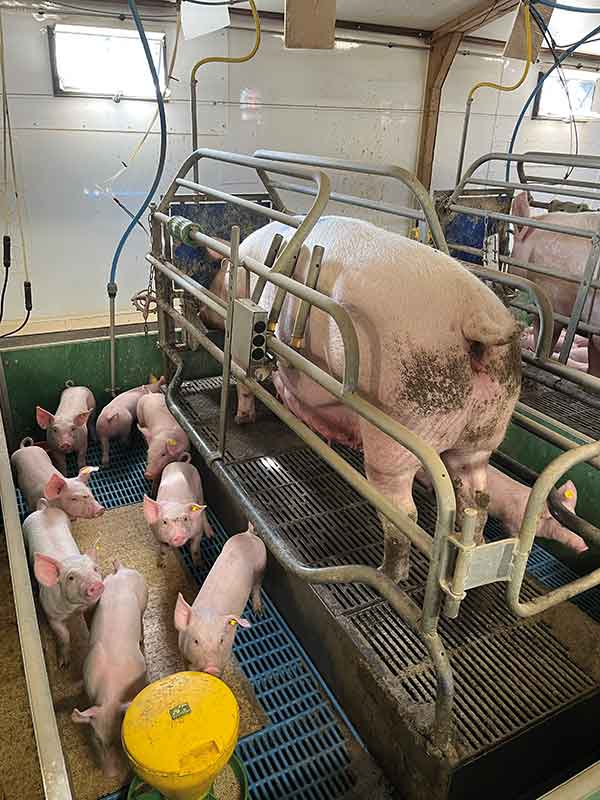
Since 1998, Harper Adams University has operated a number of different farrowing systems, including an early version of a flexible farrowing pen, which the team managed with good results for 15 years until it needed replacing.
Today the unit’s farrowing rooms include a combination of conventional farrowing pens and Nooyen crates, with a moveable floor where the sow’s area lifts up or down when she stands or sits to help protect piglets.
“The industry really needs agreed guidance on farrowing systems and future legal requirements,” said Alan Stewart, pig specialist and senior lecturer at the university.
“At our current levels of performance, to minimise mortality, maximise output and improve welfare of the sow and litter, I would choose a flexible farrowing pen of at least 6.5sq m, with the Nooyen ‘up-and-down’ moveable floor. To allow for flexibility in managing individual litters, I’d open up the pen and release the sow after seven days, then turn off the moveable floor.”
The environment in the farrowing, weaning and finishing rooms has also been enhanced by retrofitting an evaporative cooling – or misting – system.
The cooling system comes on automatically during hot weather and sow data has shown it prevents any reduction in feed intakes and milk production caused by increased temperatures.
“All piglets on the farm are tagged with electronic ID tags at birth for our research trials, but we benefit from the individual pig data, and many commercial farms could also justify it,” said Mr Stewart, who established the unit 28 years ago.
He highlighted other notable elements of the unit, which has been a closed herd since 2017, including the fact that there has been no zinc oxide in weaner diets since the unit opened, and no tail docking since 2021.
Key to the unit’s success, he said, is training, the system they use and the day-to-day work, which all add up.
“Our philosophy, right from the word go, was to let the pigs do what they do naturally and not interfere with them, and give them the management they need for that to happen,” Mr Stewart said.
Ceva Academy – supporting the pig sector
Following an engaging series of speaker presentations, Ceva Animal Health unveiled its dedicated learning platform, Ceva Academy.
It has been created to support veterinary professionals, students, producers and stockpeople in their ongoing development.
Natasha Willows, Ceva’s swine product manager, shared the inspiration and goals driving the initiative.
“The Ceva Academy offers access to training, educational resources and practical tools that enhance knowledge and professional development within the animal health sector,” she said.
She highlighted the range of courses available to vets and producers, including practical tips and strategies for achieving high-quality piglets, as well as the launch of a new porcine circovirus type 2 course.
An exclusive new course will be available in November on the Ceva Academy, in collaboration with Harper Adams University, entitled ‘Maximising weaned litter weight’.
It offers practical, research-based guidance on optimising early-life care, nutrition and housing to support larger litters and improve piglet viability.
Aimed at producers and stockpeople, the platform provides on-farm strategies to boost productivity while maintaining welfare and sow performance.
Users can sign up to the Ceva Academy to access a bespoke course by visiting www.ceva.vbms-training.co.uk.
Ms Willows described the event as a great success. “It highlighted the importance of collaboration between academia, veterinary practice and industry in driving innovation and improving pig health and performance,” she said.
“Ceva Animal Health and Harper Adams University were delighted to host such an engaging event, sharing knowledge and exploring the future of pig production.”




